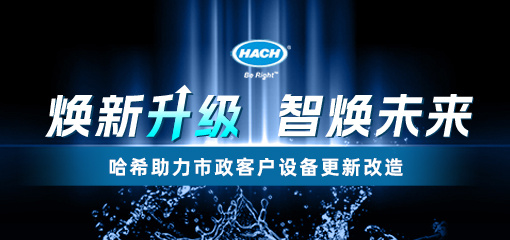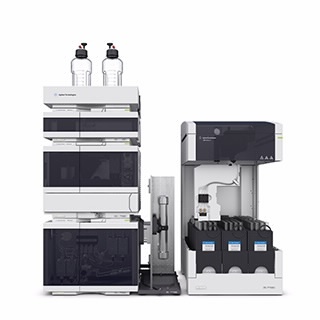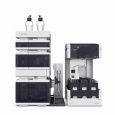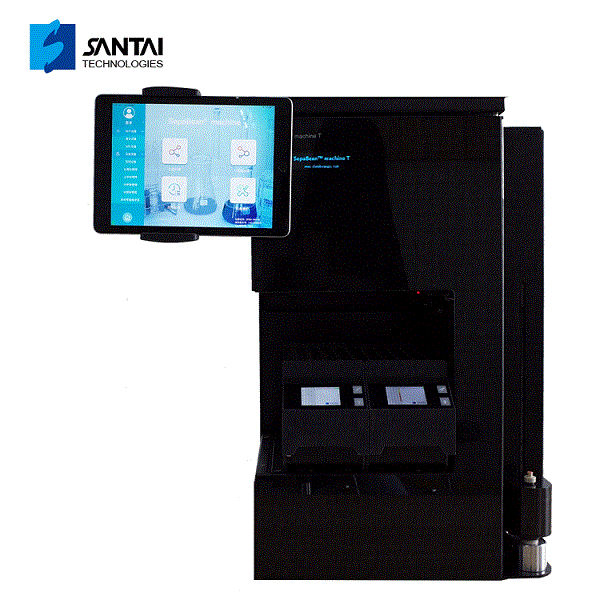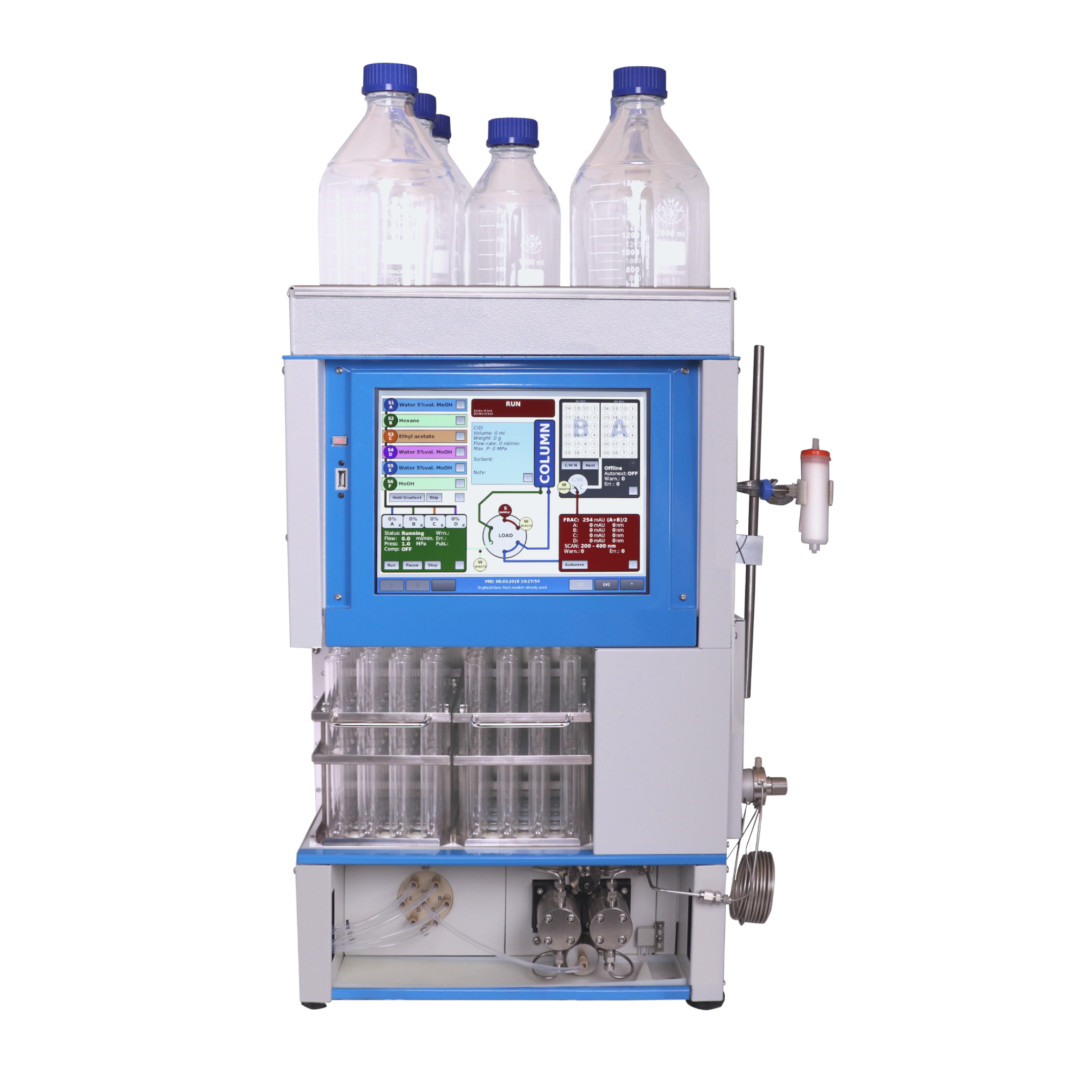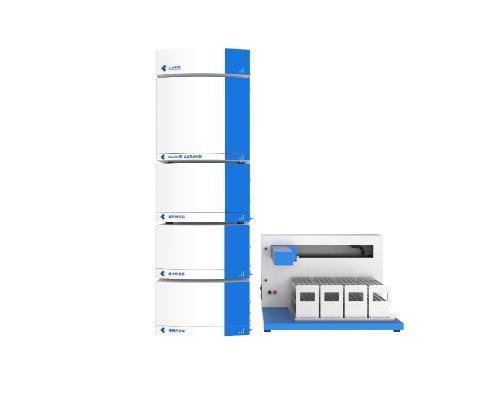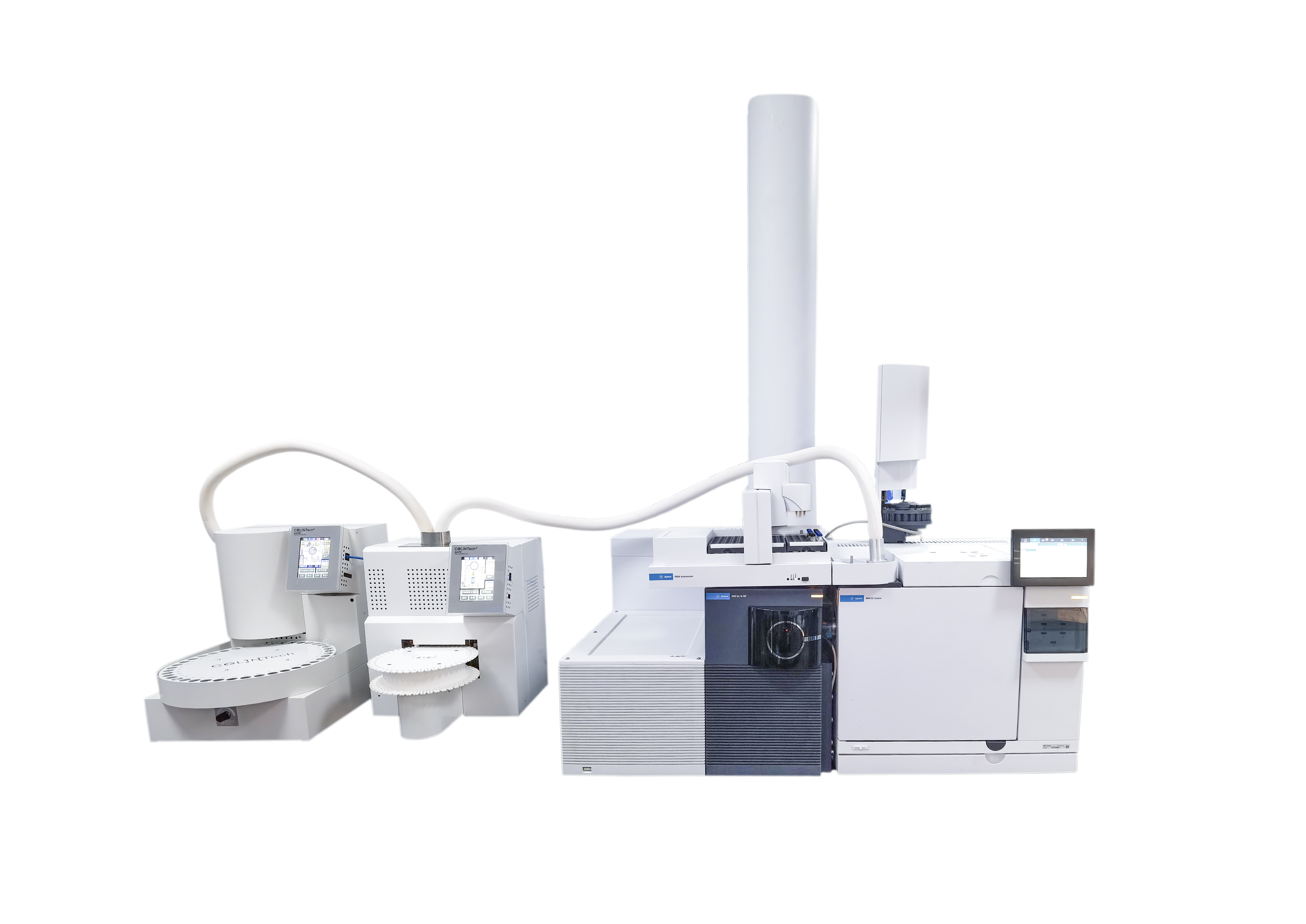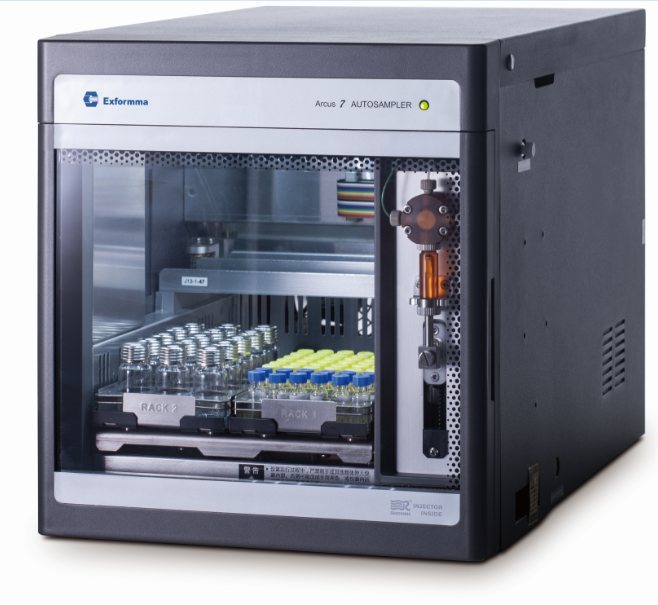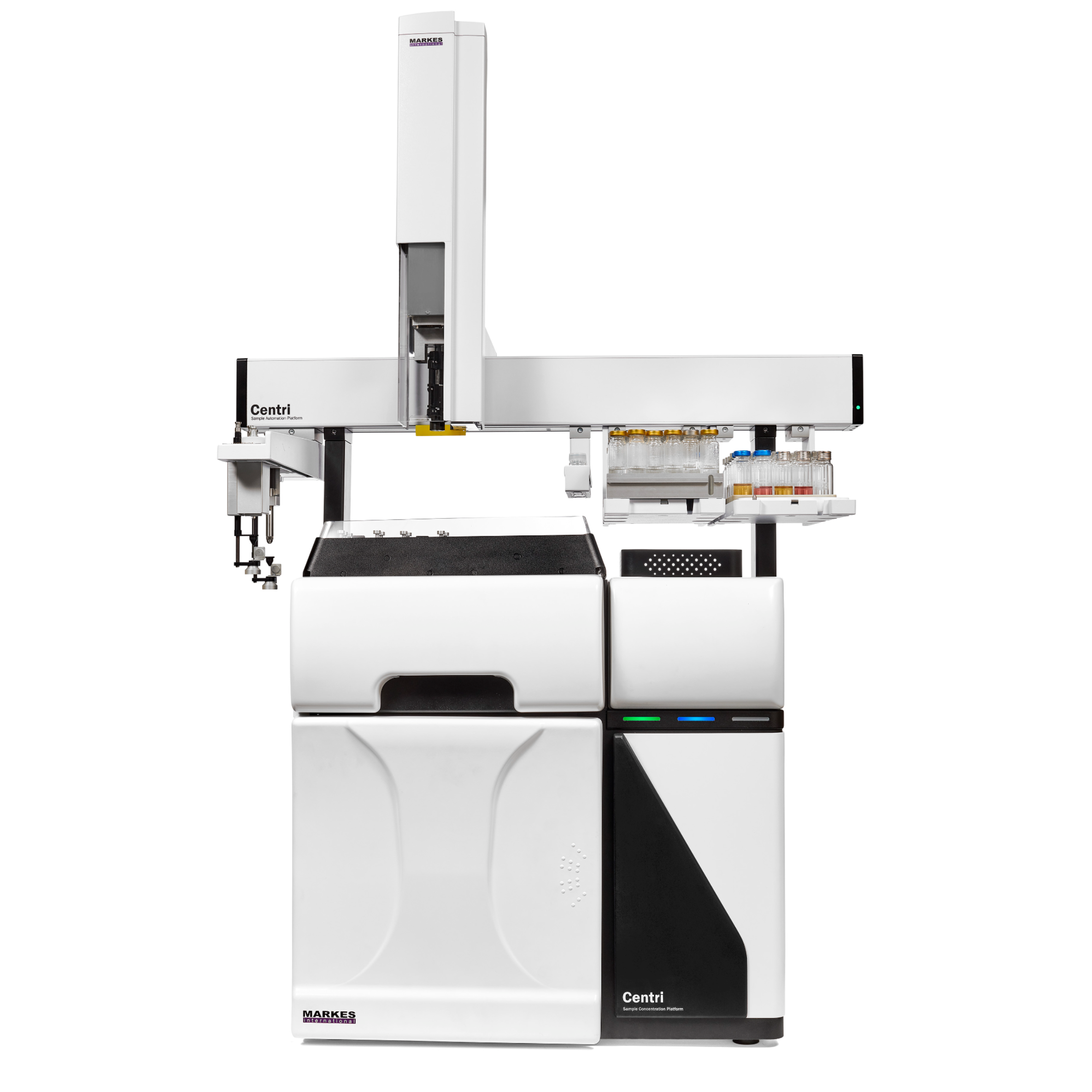On the Agilent OpenLAB CDS, fraction collection can be performed with a UV detector, or any additional detector, such as an Evaporative Light Scattering Detector (ELSD). In another Technical Overview1 , we described a simple way to split the preparative fl ow on the Agilent preparative LC systems to trigger the collection with an ELSD.
This Technical Overview shows how to optimize peak-based fraction collection triggered by an ELSD. We describe the system setup, the delay calibration between detector and fraction collector, and the use of the variable light sensitivity of the Agilent 1260 Infi nity Evaporative Light Scattering Detector. We also discuss the peak-based fraction collection settings required to achieve the best purity and recovery.
方案详情

Optimizing Fraction CollectionTriggered by the Agilent 1260 InfinityEvaporative Light Scattering Detectoron the Agilent Purification Systems Technical Overview Author Abstract Pierre Penduff Agilent Technologies, Inc. Waldbronn, Germany On the Agilent OpenLAB CDS, fraction collection can be performed with a UVdetector, or any additional detector, such as an Evaporative Light ScatteringDetector (ELSD). In another Technical Overview, we described a simple way tosplit the preparative flow on the Agilent preparative LC systems to trigger thecollection with an ELSD. This Technical Overview shows how to optimize peak-based fraction collectiontriggered by an ELSD. We describe the system setup,the delay calibrationbetween detector and fraction collector, and the use of the variable lightsensitivity of the Agilent 1260 Infinity Evaporative Light Scattering Detector. Wealso discuss the peak-based fraction collection settings required to achieve thebest purity and recovery. O@ Agilent Technologies The evaporative light scattering detector(ELSD) is commonly used to detectcompounds without a chromophore.Therefore, it is ideal for the purificationof amino acids,peptides, carbohydrates,and lipids. Using the Agilent Splitter Kitscorresponding to the required purificationscale on the Agilent Purification System',the signal from the ELSD can be usedfor peak-based collection of the targetcompounds. To ensure the best reliabilityand purity of the collected fractions,several parameters need to be optimized. The delay time between the detectorand the fraction collector needs to bemeasured. This delay is the differencebetween the time the compound ismonitored in the detector, and thetime when this compound reaches thediverting valve of the fraction collector.Correct measurement of this delaytime is an important step of the systemoptimization. This procedure is automatedon the Agilent 1260 Infinity FractionCollectors using Agilent Lab AdvisorSoftware. This Technical Overview also describeshow to improve parameters such asthe light intensity of the ELSD, and thefraction collector settings. Experimental Instrument Experiments were performed on theAgilent 1260 Infinity Preparative-scalePurification LC System: Agilent 1260 Infinity PreparativePumps (G1361A, G1391A) Agilent 1260 Infinity PreparativeAutosampler (G2260A) Agilent 1260 Infinity MultipleWavelength Detector VL(G1365D)equipped with a Quartzflow cell 0.06-mm path length(G1365D#026) Agilent 1200 Series Column/ValveOrganizer (G1383A) Agilent 1260 Infinity Preparative-scale Fraction Collector (G1364B) Agilent 1260 Infinity EvaporativeLight Scattering Detector (G4260B) Agilent 1200 Infinity SeriesUniversal Interface (G1390B), Agilent Splitter Kit 8-40 mL/min,Preparative (5023-2257) Figure 1. Schematic view of the splitter configurations of the Agilent 1260 Infinity Purification Systems,an Agilent 218 Purification System, and an Agilent SD-1 Purification System. Generic system overview ELSDs are destructive detectors,therefore, the preparative flow is splitafter UV detection. As shown in Figure 1,the main flow goes to the fractioncollector, and the split flow to the ELSD. To trigger the fraction collection with theAgilent 1260 Infinity ELSD, the signaloutput of the detector is connected toa Universal Interface Box (UIB) on anAgilent 1260 Infinity Purification Systemor a Control Interface Module (CIM) onthe 218 and SD-1 Purification System. TheUIB is an additional module connectedto the LC system through a CAN cable.The CIM is a module part of the 218 andSD-1 pumps (more details in the splitterinstallation and configuration guide2). Column Agilent ZORBAX SB-C18, Prep HTCartridge 21.2×100 mm, 5 pm(870100-902) with end fittings(820400-901) Software Agilent OpenLAB CDS A.01.05 orgreater (ChemStation Edition) Agilent Lab Advisor Software,Rev.B.02.04 Fraction Collector Solvents and samples Solvent AWater + 0.1 % formic acid, Solvent BAcetonitrile + 0.1 % formic acid Purification mixture for preparative runsCaffeine (5 mg/mL),Methyl-4-hydroxy-benzoat (2.5 mg/mL).Ethyl-4-hydroxy-benzoat (2.5 mg/mL),Propyl-4-hydroxy-benzoat (2.5 mg/mL),Benzyl-4-hydroxy-benzoat (2.5 mg/mL),Acetyl-protected sucrose (4.9 mg/mL) in DMSO All solvents used were LC grade, notdegassed. Fresh ultrapure water wasobtained from a Milli-Q Integral systemequipped with a0.22-um membranepoint-of-use cartridge (Millipak, EMDMillipore, Billerica, MA, USA). Results and Discussion Delay time calibration for ELSD peak-based fraction collection The delay time is the time a compoundneeds to travel between the point ofdetection and the fraction collector. Thisdelay is measured for each detector usinga calibration mixture. The delay time calibration on the Agilent1260 Infinity Purification Systems isperformed using the Agilent Lab AdvisorSoftware3.With the Fraction DelavSensor (FDS) of the 1260 Infinity FractionCollectors, the delay time calibrationis automated and measured during asimple and quick procedure. During thisprocedure, the delay time is measuredbetween the signals coming from the IUBand the fraction collector FDS, and thenconverted into a delay volume. Duringa purification run, the resulting delayvolume is recalculated into a delay timedepending on the flow rates used. After completion of the task, the resultingdelay volume is displayed. For the systemconfiguration used for this TechnicalOverview, the delay volume between theELSD and fraction collector was 2,739 uL On the Agilent 218 and SD-1 PurificationSystems, the delay time calibration isperformed during an OpenLAB CDSChemStation run. The resulting delay timebetween the CIM signal and the fractioncollector is saved into the methodparameters for the operating preparativeflow rate used during the purification run. Fraction collector and ELSDsettings The automated collection of the peakscan be performed on time-basedfractionation mode, on peak-based mode,or a combination of both collectionmodes. The adjustment of the peak-basedcollection can be optimized with respectto the peak shapes of the compounds Figure 2. ELSD delay volume result shown on the Lab Advisor Software .purified and also considering the loadingof the injected mixture. This step involvesa preliminary work on the analyticalcolumn or by performing a pilot run todefine threshold, upslope,and downslope. Due to the high sensitivity of the ELSD,under high concentration, saturation ofthe detector can be observed. As shown on Figure 3, the sensitivitycould be decreased on the 1260 InfinityELSD by reducing the light intensity. Theupper threshold of the fraction collectorcan also be adjusted below the saturationof the detector to prevent slope triggeringat the saturation of the detector. For theELSD, as shown in Figure 3, an upperthreshold of 1.000 mV can be used. In OpenLAB CDS A.01.05., onlinepeak-based manual collection is possible(Figure 4). When the collection istriggered manually, the delay volumebetween the detector and fractioncollector is considered (2,939 pL).Therefore, in this purification exampleat 29 mL/min, the fraction collectorwill start and stop the fractionation5.7 seconds after the operator activatesor deactivates the manual trigger. Conclusion This Technical Overview shows howto optimize fraction collection with theAgilent 1260 Infinity Evaporative LightScattering Detector. The delay calibrationperformed with the Lab AdvisorSoftware provides a simple and quickmethod to calibrate the delay volumebetween detector and fraction collection.With the possibility of light intensityadjustment, the 1260 Infinity ELSDoffers a flexible solution for preparativeliquid chromatography by increasing ordecreasing the sensitivity of the detectorwith respect to the sample concentration.These features ensure best reliability ofthe purification results. References 1. Penduff, P., Sample PurificationTriggered with the Agilent 1260 InfinityEvaporative Light Scattering Detector,Agilent Technologies Application Note,publication number 5991-4041EN.March 2014. 2. Agilent Splitter Kits: Installationand Configuration Guide. AgilentTechnologies Kit Guide, publicationnumber 5974-0158EN, February 2014. 3. Agilent 1260 Infinity Analytical- andPreparative-scale Fraction Collectors,Agilent Technologies User Manual,publication number G1364-90104,October 2013. Figure 4. Manual collection on the ELSD signal peak based. This collection was triggered through thefraction collector user interface shown here. Abstract On the Agilent OpenLAB CDS, fraction collection can be performed with a UV detector, or any additional detector, such as an Evaporative Light Scattering Detector (ELSD). In another Technical Overview1 , we described a simple way to split the preparative fl ow on the Agilent preparative LC systems to trigger the collection with an ELSD. This Technical Overview shows how to optimize peak-based fraction collection triggered by an ELSD. We describe the system setup, the delay calibration between detector and fraction collector, and the use of the variable light sensitivity of the Agilent 1260 Infi nity Evaporative Light Scattering Detector. We also discuss the peak-based fraction collection settings required to achieve the best purity and recovery.IntroductionThe evaporative light scattering detector (ELSD) is commonly used to detect compounds without a chromophore. Therefore, it is ideal for the purifi cation of amino acids, peptides, carbohydrates, and lipids. Using the Agilent Splitter Kits corresponding to the required purifi cation scale on the Agilent Purifi cation System1 , the signal from the ELSD can be used for peak-based collection of the target compounds. To ensure the best reliability and purity of the collected fractions, several parameters need to be optimized. The delay time between the detector and the fraction collector needs to be measured. This delay is the difference between the time the compound is monitored in the detector, and the time when this compound reaches the diverting valve of the fraction collector. Correct measurement of this delay time is an important step of the system optimization. This procedure is automated on the Agilent 1260 Infinity Fraction Collectors using Agilent Lab Advisor Software. This Technical Overview also describes how to improve parameters such as the light intensity of the ELSD, and the fraction collector settings.Conclusion This Technical Overview shows how to optimize fraction collection with the Agilent 1260 Infi nity Evaporative Light Scattering Detector. The delay calibration performed with the Lab Advisor Software provides a simple and quick method to calibrate the delay volume between detector and fraction collection. With the possibility of light intensity adjustment, the 1260 Infi nity ELSD offers a fl exible solution for preparative liquid chromatography by increasing or decreasing the sensitivity of the detector with respect to the sample concentration. These features ensure best reliability of the purifi cation results.
确定
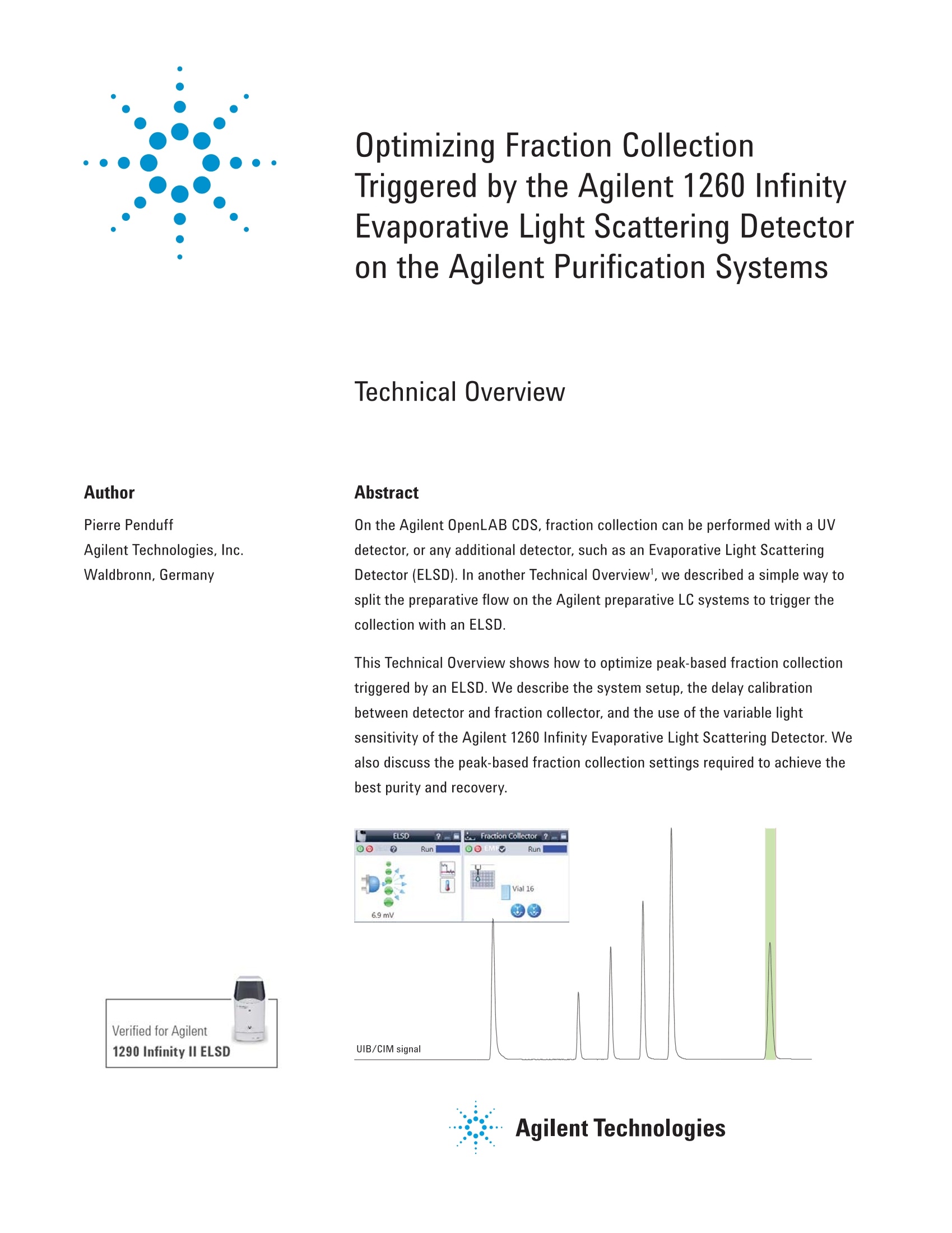
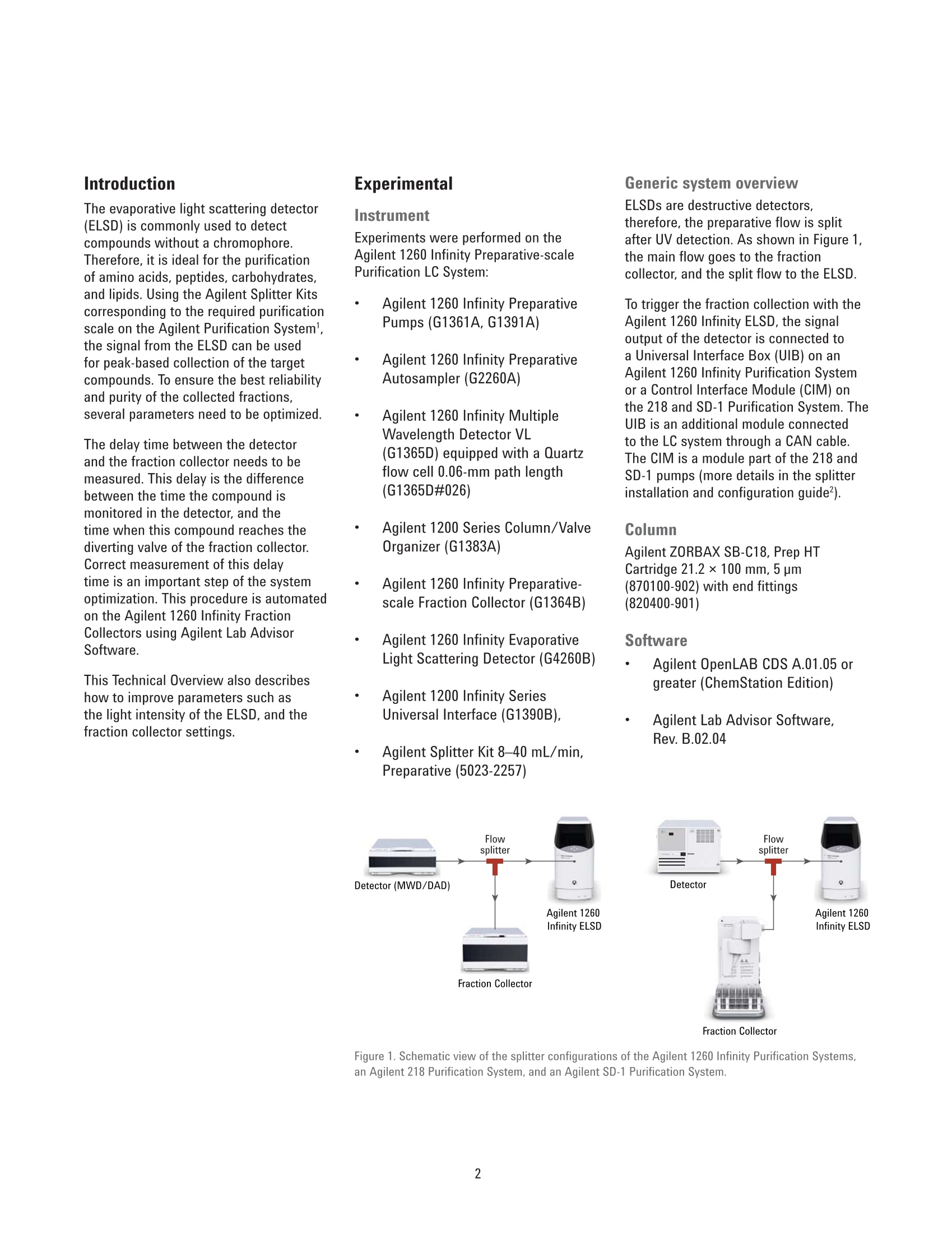
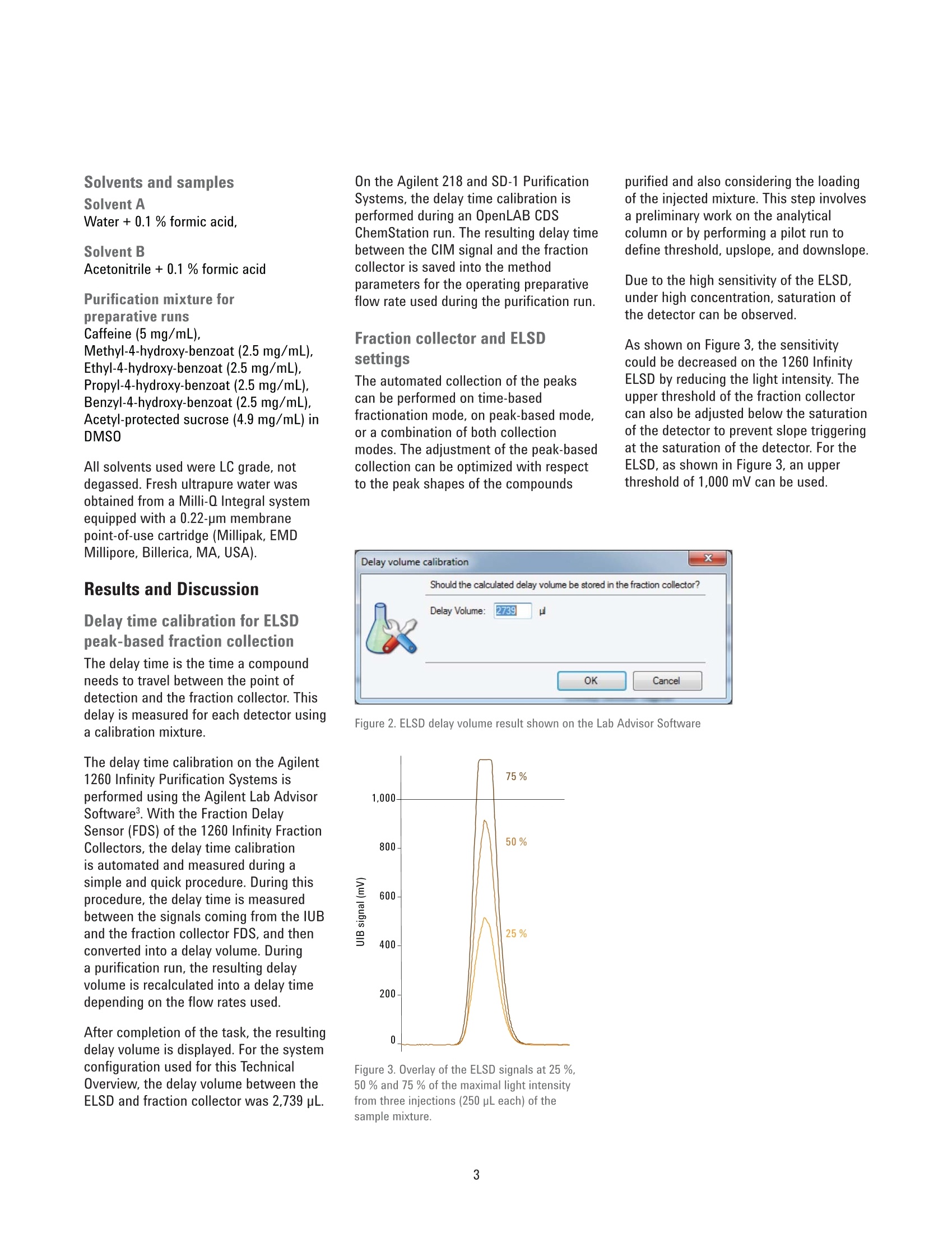
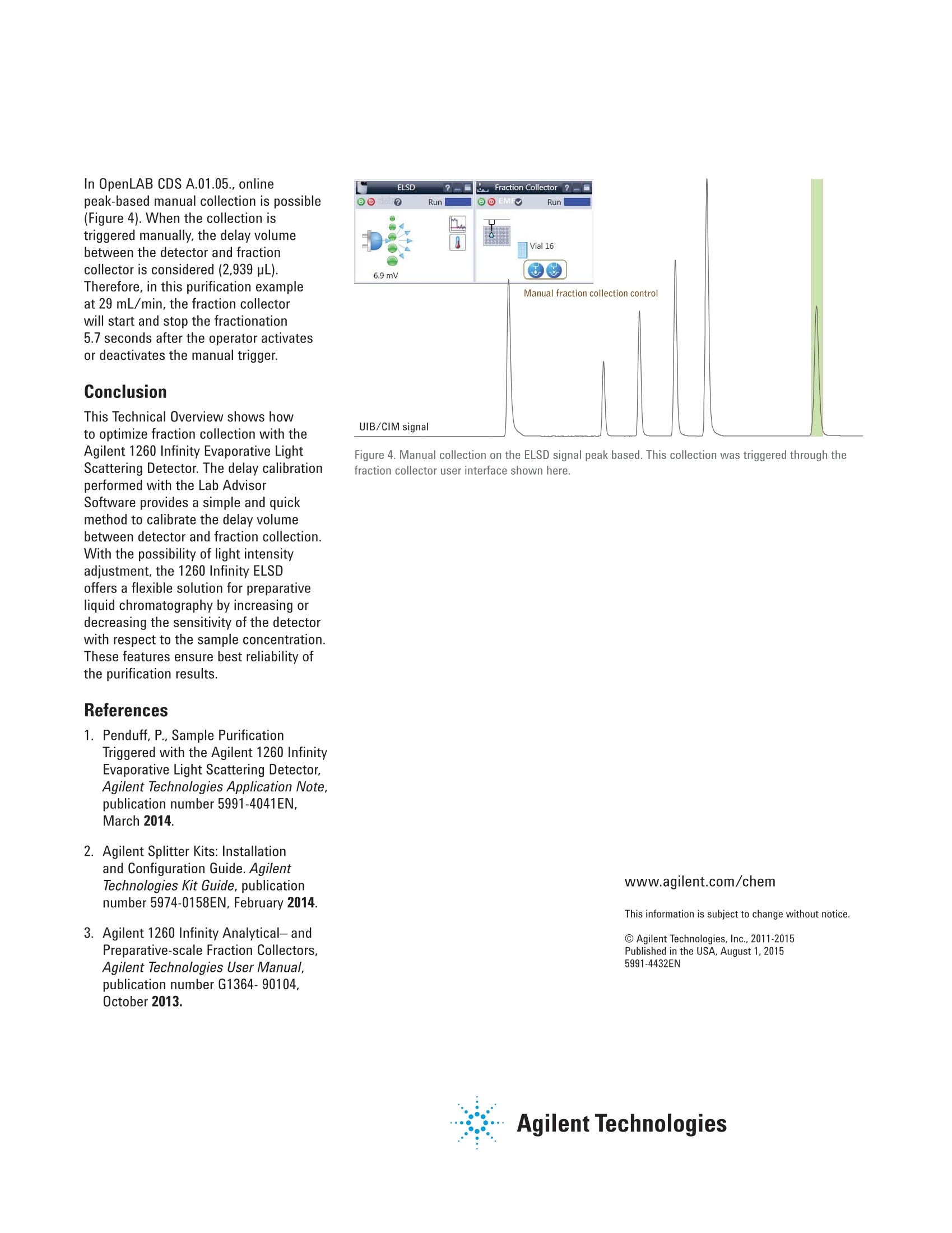
还剩2页未读,是否继续阅读?
安捷伦科技(中国)有限公司为您提供《混合标样中咖啡因,甲基-4-羟基苯甲酸等检测方案(制备液相色谱)》,该方案主要用于其他中其他检测,参考标准--,《混合标样中咖啡因,甲基-4-羟基苯甲酸等检测方案(制备液相色谱)》用到的仪器有Agilent 1260 Infinity II 制备型液相色谱、Agilent 1290 Infinity II Multisampler、OpenLAB 软件
推荐专场
相关方案
更多
该厂商其他方案
更多

